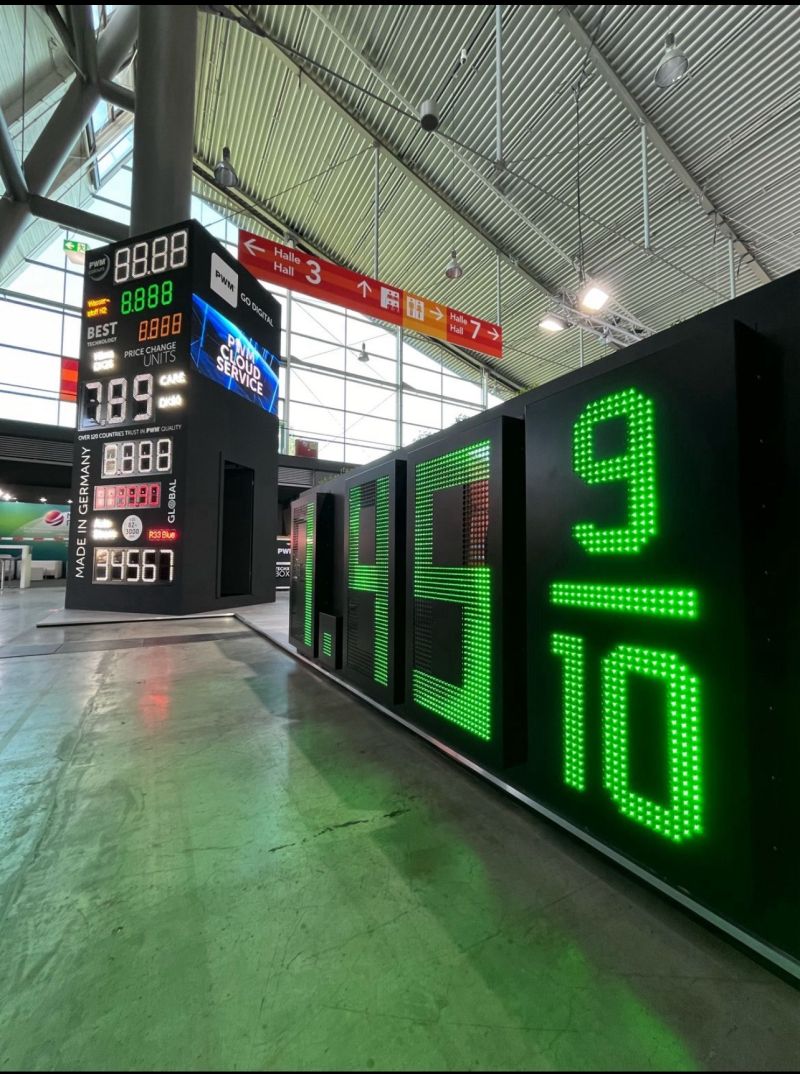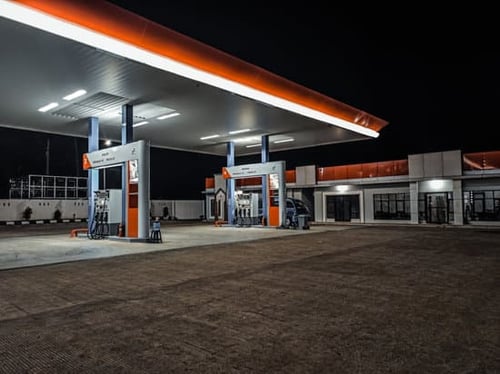
The world is rapidly changing but some things stay the same such as profit margins for gas stations and retail fuel which over the years have remained as thin as butterfly wings. In this competitive environment, the price sign remains the first point of contact for many potential customers.
As technology evolves, so does the effectiveness of these crucial marketing tools.
Enter Surface Mounted Device (SMD) LED technology – a game-changer in the price sign industry with PWM becoming the first manufacturer to develop white SMD digits in 2007 and then launching full-color digits in 2015.
Let's explore how SMD compares to traditional LED technology and why it's becoming the preferred choice for businesses worldwide.
Can You See Me Now? The Power of Visibility
Your price sign is more than just a display; it's one of your most important marketing tools.
In an industry where pennies can make the difference between a customer stopping or driving by, the clarity and visibility of your pricing can significantly impact your bottom line.
As Michael Gray from G&M Oil Company notes, "The brightness and 120-degree angle visibility of the PWM SMD electronic price signs help make G&M Chevron and Independent stations stand out from the competition. We continue to see increased customer activity at our stations."
This increased customer activity is not just anecdotal. Studies have shown that clear, visible pricing can increase drive-up traffic with almost 1 in 10 drivers making an unplanned stop to fill up if they spot an affordable gas price.
In a market where margins are tight, this can translate to substantial revenue gains over time.
What is LED?
Light Emitting Diode (LED) technology has been the standard in electronic displays for decades. Traditional LEDs are semiconductor devices that emit light when an electric current passes through them.
In price signs, these LEDs are typically arranged in a seven-segment display to form numbers.
While traditional LEDs have served the industry well, they come with limitations:
- Restricted viewing angles, often less than 90 degrees.
- Larger size, leading to bulkier signs that can be less aesthetically pleasing.
- Higher energy consumption, increasing operational costs over time.
- Less durability in outdoor conditions, particularly in extreme weather.
- Limited brightness, which can be an issue in bright sunlight.
Despite these limitations, LED technology represented a significant improvement over older neon and incandescent displays, offering longer life and better energy efficiency.
However, the industry has continued to evolve, leading to the development of SMD technology.
Introducing SMD Technology
Surface Mounted Device (SMD) technology represents the next evolution in LED displays. SMD LEDs are actually multiple LED chips grouped together.
SMD LEDs are mounted directly onto the surface of a printed circuit board, allowing for a much more compact and efficient design.
This fundamental change in how LEDs are manufactured and installed has led to a range of benefits that are particularly valuable in the price sign industry:
- Slimmer Design: SMD LEDs allow for incredibly flat and sleek price signs. The compact nature of SMD technology means that signs can be as thin as a few millimeters, opening new possibilities for sign placement and design.
- Increased Visibility: With a 120-degree viewing angle, SMD signs are visible from almost any approach. This wide viewing angle ensures that your prices are readable from multiple lanes of traffic, increasing the likelihood of attracting customers.
- Energy Efficiency: SMD technology significantly reduces power consumption. Compared to traditional LEDs, SMD displays can use less energy, leading to cost savings over the life of the sign.
- Enhanced Durability: SMD LEDs are more resilient to environmental factors. The compact design and advanced manufacturing techniques make these displays more resistant to vibration, temperature fluctuations, and moisture.
- Superior Light Quality: SMD provides brighter, more uniform illumination. The closer spacing of LEDs in SMD displays results in a smoother, more cohesive light output, enhancing readability and overall aesthetic appeal.
- Flexible Design Options: The small size of SMD LEDs allows for more creative and complex designs, enabling the creation of curved displays or intricate shapes that were previously impractical with traditional LEDs.
|
Feature |
Traditional LED |
SMD LED |
|
Design |
Bulkier, typically several inches thick |
Extremely flat, often less than an inch thick |
|
Visibility |
Limited viewing angle, usually <90˚ |
120-degree viewing angle |
|
Energy Efficiency |
Higher consumption |
Consumes less Energy |
|
Durability |
Less resilient to environmental factors |
Highly resistant to vibration, temperature, & moisture |
|
Light Quality |
Good, but can appear pixelated |
Unsurpassed, with smooth & uniform illumination |
|
Waterproofing |
Varies, often requiring additional housing |
IP67 rated (PWM), fully waterproof |
|
Maintenance |
More frequent replacements needed |
Longer lifespan, less frequent maintenance |
|
Heat Management |
Can overheat in extreme conditions |
Advanced thermal management for consistent performance |
PWM: Pioneering SMD Innovation
As the FIRST manufacturer to develop SMD digits over a decade ago, PWM has been at the forefront of this technological revolution. In 2007, PWM began series production of price signs with white SMD digits, fundamentally changing the market.
This early adoption and continued innovation have allowed PWM to refine and perfect its SMD technology, resulting in a product that leads the industry in quality and performance.
PWM's SMD Technology Features:
- LED Backlight: Long service life with enormous energy savings. PWM's backlighting technology ensures even illumination across the entire display, enhancing readability in all lighting conditions.
- Z-Diode Protection: Safeguards against high voltage and heat, preserving LED lifespan. This proprietary protection system significantly extends the life of the LEDs, reducing maintenance needs and replacement costs.
- Advanced Thermal Management: SMD LEDs lie flat on the interface, efficiently dissipating heat. This design feature prevents overheating, one of the primary causes of LED failure, ensuring consistent performance even in hot climates.
- OPS-2 (Outdoor Protection System): Proprietary potting technology ensuring IP67 waterproofing for SMD LED digits. This advanced protection system allows PWM's signs to withstand harsh weather conditions, from heavy rain to snow and ice.
- TRACK Communication Technology: Introduced in 2016, TRACK allows for real-time monitoring and control of individual SMD LEDs. This innovative system enables proactive maintenance and rapid response to any issues, minimizing downtime and ensuring optimal performance.
Beyond Price Signs: Expanding Your Marketing Reach
While price signs are crucial, PWM's technology extends beyond just displaying numbers. Their LED profit boards and message displays offer dynamic advertising opportunities, allowing you to communicate directly with passing traffic and promote special offers or additional services.
These versatile displays can be used to:
- Advertise in-store promotions.
- Display community messages.
- Promote loyalty programs.
- Highlight non-fuel services (car wash, convenience store specials, etc.).
By leveraging these advanced display capabilities, businesses can turn their price signs into powerful marketing tools that do more than just show fuel prices.
As we look to the future, it's clear that SMD technology is not just a trend, but the new standard in price sign displays. With PWM's innovative solutions, including their patent-pending retrofit option, upgrading to this cutting-edge technology has never been more accessible or affordable.
Your price sign is often the first impression you make on potential customers. Contact PWM today to see how their SMD LED technology can help protect your profit margin.






